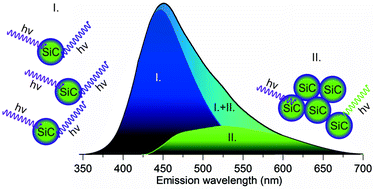Dominant luminescence is not due to quantum confinement in molecular-sized silicon carbide nanocrystals†
Abstract
Molecular-sized colloid silicon carbide (SiC) nanoparticles are very promising candidates to realize bioinert non-perturbative fluorescent nanoparticles for in vivo bioimaging. Furthermore, SiC nanoparticles with engineered vacancy-related emission centres may realize magneto-optical probes operating at nanoscale resolution. Understanding the nature of molecular-sized SiC nanoparticle emission is essential for further applications. Here we report an efficient and simple method to produce a relatively narrow size distribution of water soluble molecular-sized SiC nanoparticles. The tight control of their size distribution makes it possible to demonstrate a switching mechanism in the luminescence correlated with particle size. We show that molecular-sized SiC nanoparticles of 1–3 nm show a relatively strong and broad surface related luminescence whilst the larger ones exhibit a relatively weak band edge and structural defect luminescence with no evidence of quantum confinement effect.



 Please wait while we load your content...
Please wait while we load your content...